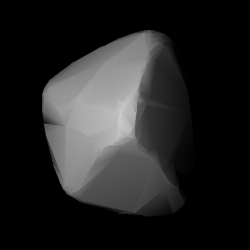 Shape model of Tyumenia from its lightcurve | |
| Discovery [1] | |
|---|---|
| Discovered by | T. Smirnova |
| Discovery site | Crimean Astrophysical Obs. |
| Discovery date | 9 September 1967 |
| Designations | |
| (2120) Tyumenia | |
Named after | Tyumen Oblast [2] (Western Siberia) |
| 1967 RM ·1941 WS 1971 KA | |
| main-belt ·(outer) [3] background [4] | |
| Orbital characteristics [1] | |
| Epoch 4 September 2017 (JD 2458000.5) | |
| Uncertainty parameter 0 | |
| Observation arc | 75.96 yr (27,746 days) |
| Aphelion | 3.4494 AU |
| Perihelion | 2.6682 AU |
| 3.0588 AU | |
| Eccentricity | 0.1277 |
| 5.35 yr (1,954 days) | |
| 162.29° | |
| 0° 11m 3.12s / day | |
| Inclination | 17.573° |
| 222.46° | |
| 75.509° | |
| Physical characteristics | |
| 38.619±0.412 km [5] 40.93 km (derived) [3] 41.18±2.4 km [6] 43.65±20.27 km [7] 43.90±0.80 km [8] 47.00±14.23 km [9] 51.485±0.395 km [10] | |
| 2.769±0.001 h [11] [a] 17.47±0.07 h [12] 17.507±0.006 h [13] | |
| 0.029±0.005 [10] 0.03±0.02 [7] 0.03±0.03 [9] 0.0420 (derived) [3] 0.064±0.003 [8] 0.068±0.003 [14] 0.0721±0.009 [6] 0.0819±0.0132 [5] | |
| C (assumed) [3] | |
| 10.40 [5] [6] [8] ·10.90 [9] [10] ·11.0 [1] [3] ·11.14 [7] | |
2120 Tyumenia (prov. designation: 1967 RM) is a dark background asteroid, approximately 45 kilometers (28 miles) in diameter, located in the outer regions of the asteroid belt. It was discovered on 9 September 1967, by Soviet astronomer Tamara Smirnova at the Crimean Astrophysical Observatory in Nauchnyj, on the Crimean peninsula. [15] The asteroid was named for the now Russian district of Tyumen Oblast in Western Siberia. [2]